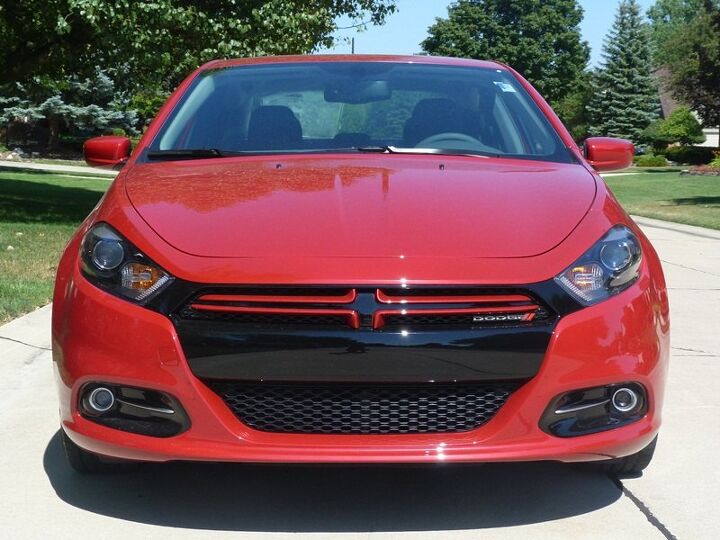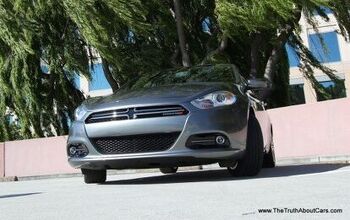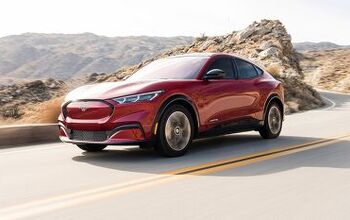Review: 2013 Dodge Dart SXT Rallye
You’ve got to give Sergio Marchionne credit for at least one thing: he’s a masterful negotiator. The Italian-Canadian FIAT exec bluffed General Motors into paying $2 billion for the right to NOT buy the Italian company. He went on to acquire a controlling stake in Chrysler for no cash. Instead, FIAT agreed to provide the auto maker, hollowed out by Daimler and Cerberus, with powertrains and platforms. Three years after that deal, Chrysler has introduced the first car developed for North America around FIAT innards, the compact Dodge Dart sedan ( pre-production review).
Take an Alfa Romeo Giulietta hatchback, stretch it and widen it, add a trunk, and you somehow end up with a car that, aesthetically, would have fit right into Dodge’s late 1990s lineup. The distended front clip and clean, rounded surfaces recall those of the Avenger coupe, with a hint of second-generation Neon. But the height of the car is pure 2012, so there’s a lot more metal over the wheel openings than you’d have found on a circa-2000 Dodge. Perhaps the Dart will look right in R/T form (coming this fall). The SXT Rallye’s wheels, though 17 inches in diameter, appear undersized. This said, those who find the styling of Ford Focus and Hyundai Elantra overwrought might prefer the Dart’s simpler forms.
Parts of the Dart’s interior appear similarly dated, with the center stack and console marked by the organic shapes and non-flush faceplates of a 1990s Pontiac. Other parts, most notably the reconfigurable LCD instruments in the upper trim levels and the large 8.4” “Uconnect” touchscreen, could not be more current. Then there’s the grating over the speakers, which looks like it belongs in a different car on a different continent, if not a different planet. This hodgepodge cleans up fairly well in the upper trim levels, where the hood over the instruments is upholstered, the upper IP surround is lit in red, and additional splashes of color are available on the door panels and seats. The exterior is available in a dozen colors, while the interior is offered in 14 trim combinations, both numbers well above the current segment norm. For some reason, though, all of the cars I saw on dealer lots were drably outfitted in black or, worse, gray. Materials quality is fairly good, with cushy armrests among the many soft-touch surfaces, but isn’t quite up to that inside a Ford Focus or a Chevy Cruze.
Drop down into the driver’s seat and the first thing you notice is that you don’t drop down very far. Compared to the Focus or Cruze, you sit high in the Dart—another aspect of the car that’s more 2000 than today. Even the base Dart has manual height adjusters on both front seats, but only the shortest people will likely employ them. This would be good for visibility—if the instrument panel were not very deep and the A-pillars were not somewhat thick and steeply raked. I drove the Dart on a hot day, and the amount of heat radiating off the top of the IP strained the A/C. The view to the rear could be Exhibit A in the case for mandatory rearview cameras. A good one with lines that trace the car’s path is packaged with the 8.4-inch screen.
The Dart’s front seats, though not entirely bereft of lateral support, feel slightly overstuffed rather than form-fitting. The German flavor of recent Ford and GM compacts is absent here, perhaps because FIAT, though European, isn’t German. Like those in the Focus and Cruze, and unlike that in the Americanized VW Jetta, the Dart’s rear seat offers barely enough headroom and legroom for six-foot-tall passengers and its cushion feels undersized.
The new Dodge Dart’s base engine is a 2.0-liter naturally-aspirated four-cylinder engine good for 160 horsepower. Spend another $1,300 and you get a turbocharged 1.4-liter engine good for…160 horsepower. But the boosted engine is considerably torquier at middling engine speeds, 184 pound-feet at 2,500 rpm vs. 148 at 4,600. Even the 2.4 that will power the R/T has less twist (171 pound-feet @4,800) if more power (184). This is what the spec sheets say, anyway. On the road, the 1.4T feels soft south of 3,000 rpm. The car’s portly, midsize sedan-like 3,200-pound curb weight doesn’t help, but a variant of the same engine also must be spun north of 3k in the 2,500-pound FIAT 500 Abarth for any semblance of alacrity. This engine will be available with a six-speed dual-clutch automated manual, but at intro was offered only with the three-pedal variety. The third pedal leaves much to be desired, grabbing with scant feedback only near the very top of its long, spongy travel. The shifter is similarly long of throw and somewhat clunky, but is passable aside from a metal knob that heats to finger-scorching temps in the sunlight.
The Dodge Dart earned FIAT five percent of Chrysler by managing over 40 miles-per-gallon in the EPA’s tests—before the adjustments to make the numbers on the window sticker realistic. The window sticker numbers aren’t terribly impressive with the 2.0: 25/36 with the manual transmission and 24/34 with the automatic. The 1.4T with the manual does better, 27/39, but still falls short of the segment’s best.
The Dart’s chassis behaves well, with decent balance, moderate lean, and minimal float or slop. Still, damping isn’t as tight as in a Ford Focus or even a Buick Verano. Between this, a feedback-free electric-assist steering system, and the ever-evident aforementioned heft the Dart lacks the character of a precision instrument. A connection between car and driver proves elusive. Those seeking isolation will be more satisfied. The Dart rides softer than either the Focus or the Elantra. If and when the HVAC blower isn’t working like mad, interior noise levels are very low. Credit the triple door seals that Lexus helped make popular in the 1990s but that bean counters have often cut in the years since.
Dodge has much ground to regain in the compact sedan segment, so you might expect the Dart to be priced aggressively. But is it? Much like Hyundai, the Dart doesn’t so much have a low price as a slightly lower price paired with more stuff. The tested middle-of-the-range SXT Rallye with 1.4T and nav listed for $22,965. About $800 of this can be chalked up to the Rallye’s sportier exterior and interior trim, probably not the best value.
Like with the Ford Focus, stepping up to a higher trim level adds more to the feature list than it does to the price. When loaded up with high-watt Alpine audio, nav, heated leather, and a sunroof, the Dodge Dart Limited 2.0 lists for $24,865. A similarly-equipped 2013 Ford Focus SE, among the most expensive cars in the segment, lists for $25,505. Adjust for feature differences using TrueDelta’s car price comparison tool, though, and the Dodge Dart ends up with a roughly $1,000 advantage thanks to features you can’t get on the Focus. These include four additional airbags, a heated steering wheel, rearview camera, rear cross-traffic detection, auto-dimming headlights, reconfigurable LCD instrumentation, and power four-way lumbar. Add the 1.4T engine to the Dodge, though, and they’re back near parity.
A 2013 Hyundia Elantra Limited with nav lists for $24,070, so less than the Dodge but not dramatically so. Adjust for feature differences and the Dodge ends up with a $500 advantage—until you add the 1.4T engine to get EPA numbers approaching the Hyundai’s.
Overall, the new Dodge Dart is a good car, even among the best in the segment, but some others are better looking, better constructed, roomier, more fun to drive, or more economical. An almost all-new car based on FIAT bits, its reliability very much remains to be seen. Its price is in the same ballpark as the Ford’s and the Hyundai’s, so until big rebates arrive, its window sticker isn’t compelling. Why buy one? A few features you can’t get anywhere else in the segment (but that won’t be found on most Darts on dealer lots) seem the most compelling reason. Is this enough? If the Ford Focus didn’t exist, I’d rate the Dart more highly. But the Focus does exist.
Brad Marshall of Suburban Chrysler in Novi, MI, provided the car. Brad can be reached at 248-427-7721.
Michael Karesh operates TrueDelta, an online source of automotive pricing and reliability data.
Michael Karesh lives in West Bloomfield, Michigan, with his wife and three children. In 2003 he received a Ph.D. from the University of Chicago. While in Chicago he worked at the National Opinion Research Center, a leader in the field of survey research. For his doctoral thesis, he spent a year-and-a-half inside an automaker studying how and how well it understood consumers when developing new products. While pursuing the degree he taught consumer behavior and product development at Oakland University. Since 1999, he has contributed auto reviews to Epinions, where he is currently one of two people in charge of the autos section. Since earning the degree he has continued to care for his children (school, gymnastics, tae-kwan-do...) and write reviews for Epinions and, more recently, The Truth About Cars while developing TrueDelta, a vehicle reliability and price comparison site.
More by Michael Karesh
Latest Car Reviews
Read moreLatest Product Reviews
Read moreRecent Comments
- Analoggrotto Anyone who has spent more than 15 minutes around a mustang owner would know this will be in insta-hit.
- FreedMike Interesting time capsule.
- 6-speed Pomodoro I had summer and winter tires for a car years ago. What a pain in the butt. You've permanently got a stack of tires hogging space in the garage and you've got to swap them yourself twice a year, because you can't fit a spare set of tires in a sportscar to pay someone else to swap 'em.I'd rather just put DWS06's on everything. But I haven't had a sportscar in 8 years, so maybe that's a terrible idea.
- ShitHead It kicked on one time for me when a car abruptly turned into my lane. Worked as advertised. I was already about to lean into the brake as I was into the horn.
- Theflyersfan I look at that front and I have to believe that BMW and Genesis designers look at that and go "wow...that's a little much." Rest of the car looks really good - they nailed the evolution of the previous design quite well. They didn't have to reinvent the wheel - when people want a Mustang, I don't think they are going to cross-shop because they know what they want.








































Comments
Join the conversation
When I first saw the new Dodge Dart, I started to laugh uncontrollably - I'm serious about this too. I literally started to shake with giggles and think to myself, "another turd finds its way to the Chryslerogio showroom." What is this "thing" that they decided was a viable, sporty automobile? And to brand it as a fun, performance car to boot! The Dart is pure douche-baggery. An effeminate-looking, wimpy, cute little mole on wheels. The car has no haunch, top-heavy stance and a terribly boring confluence of geometry that reminds me of a suppository. All was confirmed first hand, when I performed a detailed examination at the NAIAS. The interior is complete and utter "caca", a missmash of conflicting textures, poorly executed switchery, and substandard polymer choices. Texture aesthetics are absent. The dash panels are sculpted using the bloat and pucker filter in Photoshop. The black interior attempts to mask these failings - yet this tomfoolery is no match for the keen eye. What mental patient decided that the steering wheel should look like a mid-size pickup's? It is a mystery to me how car companies seem so paralyzed in design execution. It's as if the originally intended design (by the core design group) is much too scary for the public, so it the car ends up being the product of a long list of "cost-cutting" compromises and then is sent through the "tone-down" department , followed by the "make-shift" team, and ultimately ruins the car, resulting in quintessential mediocracy, boredom, and anemia. Call me a Euro-car snob, but anyone driving this car should feel embarrassed.
Bought a new 2013 Dart SE Aero, which is the high-mileage version. 1.4L SOHC Turbo, with a 6-speed manual. Long pedal travel when you push in the clutch. Silver, with a black cloth interior, and a Sirius radio. Steel wheels with plastic covers. Very smooth ride, easy steering, and quiet going down the road. My current vehicles are 20 years old, and I look forward to driving the new Dart for a least as long. I'll be driving it out West this May to Jackson Hole, Yellowstone, and Rushmore on a long road trip.